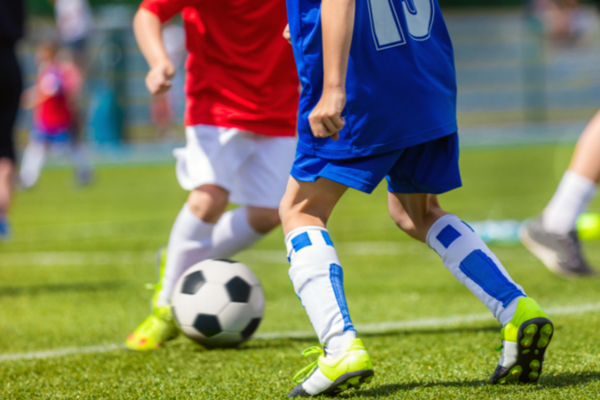
Soccer is a popular activity, whether you enjoy the occasional weekend game or your child plays through school. While this sport teaches control and teamwork, players are also vulnerable to acute and cumulative conditions. These include falls, collisions and repeating particular motions that place stress on a joint. During the season, keep the following conditions in mind.
Knee Injuries
Typically, the demands of soccer result in knee injuries, from kicking, turning and twisting to move the ball. Aside from cumulative injuries, sudden movement place rotational stress on the joint.
As a result of these factors, soccer players have a higher likelihood of experiencing a knee sprain or tear around the joint.
Conditions may include:
- Anterior Cruciate Ligament (ACL) Injury: Stems from a direct hit to the front or side of the knee, sharply changing directions or stopping short.
- Cruciate Ligament Injury: The player hears a popping sound, then experiences swelling and restricted range of motion around the knee.
- Meniscus Injuries: Affect the cartilage between the femur and tibia, as a result of twisting, pivoting or extreme impact to the knee.
Muscle and Ligament Injuries
Although the knees are particularly vulnerable, other joints and surrounding tissue can experience the following types of injuries:
- Ankle Sprains: When players kick the ball, ligaments around the ankle are at risk for tears. These bands of tissue offer support to the bones and help stabilize the joints.
- Achilles Tendonitis: This is an overuse injury affecting the ankle due to repetitive movements.
- Achilles Tendon Rupture: The tendon may fully or partially tear. Unlike with Achilles tendonitis, the injury occurs from a sharp, sudden movement.
- Groin Pull: The muscles of the inner thigh get stretched beyond their normal position, often as a result of kicking the ball too hard.
- Hamstring Strains and Rupture: The movements of soccer place constant strain on this area, from running to suddenly stopping. With time, a player can experience a sprain or muscle tear.
- IT Band Injuries: Repetitive motions and long practice sessions have potential to affect the iliotibial (IT) band. Along with tears and strain, the running involved in soccer can pull this band toward the outside of the knee, resulting in inflammation.
- Plantar Fasciitis: Tissue from the heel to the toes experiences enough inflammation that the player feels pain. Although improper technique can play a role, players may experience this when wearing old shoes with insufficient support and shock absorption.
- Shin Splints: A player who feels a sharp pain in the lower half of the leg may have a shin splint. This injury occurs as a result of extreme force being placed on the bone and surrounding muscle. This can be the result of a kick to the area, suddenly stopping or changing direction.
- Tendonitis: Tendons surrounding the joints are vulnerable to overuse injuries. Players are dealing with this condition when they feel swelling or inflammation in these areas.
Stress Fractures
Although overuse injuries affect the muscles and ligaments, soccer also places a toll on the bones. A stress fracture can occur from repeating the same movements or being kicked. Players may experience bruising or a partial crack in the area.
Head Injuries
Soccer players can experience a head injury in two ways: Hitting the ball with their head or colliding with another player or fixed object. A concussion may result from the swift and sudden impact.
Heat-Related Illnesses
When players forego hydration, they’re at risk for a heat-related illness. These can span from heat cramps to heat stroke, in which the body’s temperature rises to unhealthy levels and can’t drop back down.
How to Prevent Soccer Injuries
Aside from repetition, soccer injuries can result from practice conditions or wearing improper equipment. To reduce your or your team’s risks:
- Make sure everyone has access to sufficient hydration.
- Avoid training in hot, humid or overly sunny weather.
- Make sure uniforms fit correctly and everyone wears supportive cleats.
- Schedule a warmup for at least 30 minutes before drills or the game begins, with greater focus on the hips, Achilles tendon and groin.
- Along with clothing and footwear, make sure all players have appropriate protective gear. For soccer, this can include shin, knee, elbow guards and mouth guards.
- Make sure the field is safe to play on. Avoid playing in spaces with depressions and holes, on hard surfaces or in rainy, muddy weather, where players are likely to slip.
- If a player gets injured, keep them off the field for the rest of the game and only return to practice once properly healed.
After a soccer injury, you may be referred for physical therapy treatment.
To learn more about Integrated Rehab’s approach to knee foot and hip therapy, schedule an appointment today.

